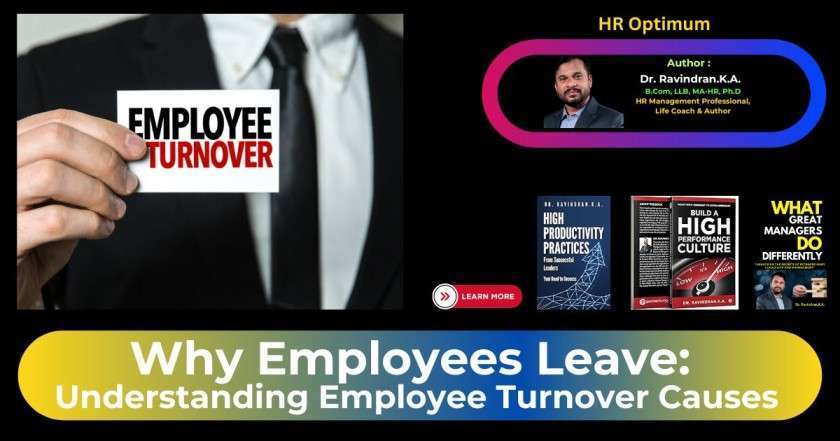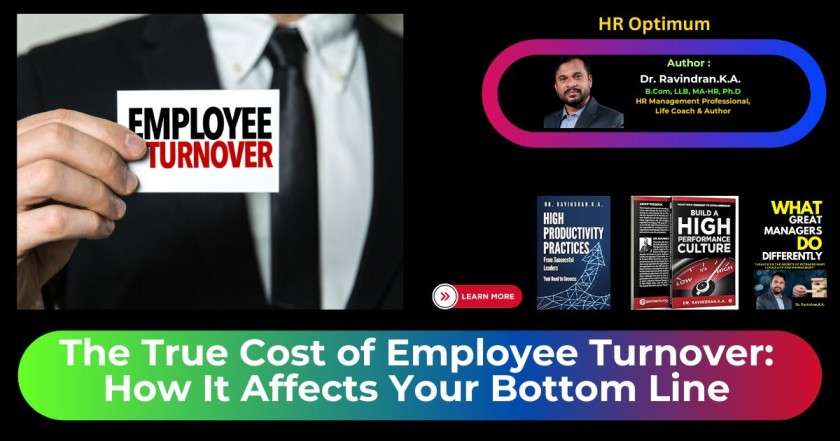Top 10 Causes of High Employee Turnover and How to Address Them
Is your best staff always moving on to new jobs? High employee turnover hurts businesses a lot. It costs money and time to find and train replacements. So, why are employees leaving, and how can you stop them? We will explore the top 10 reasons and share ways to keep your talented workers.
Thank you for reading this post, don't forget to subscribe!
Key Takeaways
- High employee turnover can be a major financial burden, costing companies an average of 33% of an employee’s salary each time they leave.
- Factors like poor compensation, lack of career development, and toxic workplace culture are common drivers of voluntary turnover.
- Investing in employee retention strategies, such as competitive benefits, robust training programs, and positive work environments, can pay dividends in terms of talent acquisition and customer satisfaction.
- Regularly gathering employee feedback and addressing their concerns is crucial for identifying and resolving the root causes of high turnover.
- Effective talent management practices, including robust onboarding processes and identifying and developing strong managers, can significantly improve employee retention rates.
Understanding Employee Turnover
Tracking employee turnover rates helps us see how many are leaving and why. Turnover includes both people who leave willingly and those who are let go. Those who leave on their own often do so for a better job, personal reasons, study purposes, or to retire. Others had to leave due to poor performance, bad behavior, a seasonal job ending, or a reduction in positions.
What Is Employee Turnover?
Having too many people leave on their own, especially more than what’s usual in your business, is not good. It means you might be losing your best workers to other companies. This can hurt how much money you make and how happy your customers are. A study found that in the U.S., 20% of employees left their jobs every year, and most left by choice.
Why Is Employee Turnover Bad?
When a lot of employees leave, it costs a lot of time and money to replace them. Every time you need to replace someone, it costs about a third of what you were paying them. But, if a company works hard to keep their team happy—by offering good benefits, chances for growth, and a nice place to work—they save a lot of money. They also end up with a team that’s happier and more eager to learn and do well.
What Is a Good Employee Turnover Rate?
On average, 10.6% of employees leave their jobs every year. But, different types of work see different rates of people leaving. Industries like professional services, tech, entertainment, hospitality, and retail have more people leaving than average. These areas see rates at 11.4% to 13.4%.
By understanding why people leave and dealing with those reasons, companies can do a better job of keeping their best workers.
Common Causes of High Employee Turnover
Many people leave their jobs for different reasons. Some want more pay or better benefits. Others seek a better balance between their work and personal life. Some look for chances to grow in their careers. There are also those leaving to deal with health issues or move to new places. Others simply want a more flexible job. And some just want to get away from bad bosses or places they don’t like.
HR teams often ask leaving employees to talk about their experiences in an exit interview. They promise them that what they say won’t harm their chances of getting a new job later. This helps the company learn and improve, whether it’s about how they treat their workforce or the kind of work they offer.
| Industry | Average Annual Voluntary Turnover Rate |
|---|---|
| Retail | Higher |
| Hospitality | Higher |
| Wholesale Distribution | Higher |
| Education | Lower |
| Finance | Lower |
Research from Mercer finds certain jobs see more people leaving each year. These include roles in customer service and sales. It suggests that many of these workers are looking for new opportunities or have had enough of their current jobs.
“Turnover due to toxic work cultures is estimated to have cost companies $223 billion over the past five years.”
1. Lack of Employee Purpose
“Workaholics” is a belief that work is the center of your life, not just a job. It affects many college-educated workers. LinkedIn’s Talent Trends Survey found that companies with clear missions have lower staff turnover.
These companies are great at motivating workers. They show how their products or services help others. They also support good causes. This makes employees feel like they are part of a bigger mission.
The Importance of a Purposeful Mission
Having a clear mission helps companies keep their employees happy. Those workers then feel like they represent the company. They see the company making a positive difference and support its charity work.
Connecting Employees to the Company’s Goals
Even companies with unmotivated workers can keep their best employees. This happens when workers understand and support the company’s mission. Helping employees see how their work matters is key. It boosts their sense of purpose and their desire to stay.
2. Poor Compensation
Compensation and benefits play a big part in why people, especially the young, leave jobs. This is according to a LinkedIn study. A higher salary keeps people at a job for a couple of reasons. It tells employees their work is valued. Plus, it makes it hard for other companies to steal them by offering more money.
The Impact of Compensation on Retention
Making sure pay and perks are as good as or better than what’s offered elsewhere is key. This is for keeping good people and for attracting new talent. To do this, companies should give raises yearly, check what competitors pay, use bonuses well, and make sure top employees are rewarded fairly.
Strategies for Competitive Compensation
A Harvard study showed that raising wages even a little in certain jobs can keep people longer. For example, boosting a warehouse worker’s pay by a dollar kept them on the job more. And high employee turnover is expensive. It costs six to nine months of a salary when someone leaves. So, offering good pay and benefits is smart for keeping a strong team and helping the company succeed.
3. Employee Burnout
Burnout affects people in various jobs, leading to many leaving their roles. It happens when folks are given tasks to do but don’t have what they need to do them well. They may also feel they have no say, or they deal with more stress than they can handle every day. This leads to feeling worn out, giving up hope, and blaming themselves for things going wrong. It can show up in how they act and their health.
Signs of Employee Burnout
Research from the University of California says that burnout can be tackled by focusing on six main areas. These include too much to do, feeling like you have no control, not getting the rewards you deserve, working in a negative environment, fairness issues, and conflicts in what you believe. If these areas are off, it raises the chances of burnout. This can lower how much folks care about their work and cause trouble in the workplace.
Reducing Burnout through Workload Management
To fight burnout, those in charge must ask their teams how they feel and make changes as needed. When organizations listen to their people and provide the right tools, the stress from too much to do and feeling powerless is lessened. It’s also important to create a work environment where people can talk openly and find a balance between work and life. This can help keep employees from leaving.
4. Bad Management
Talk abounds about toxic managers. These are people who don’t really do their job well. They might steal ideas, show favoritism, or even treat their employees badly. But what’s not often talked about are those managers who lack the skills needed to lead. Many employees leave their jobs because of bad managers. This includes things like poor pay, not enough time off, few learning opportunities, or a lack of chances to grow in their career. To fix this, HR teams should spot these unfit managers. They should then help them improve or find them a different job.
The Role of Managers in Employee Retention
Good managers act as career guides. They know their team members’ strengths and what makes them tick. According to Harvard Business Review, the best managers really get to know their team. They understand what each team member brings to the table. These managers work to use everyone’s unique skills together. They do this to craft solid plans that help both the team and the company succeed. This way of working leads to better teamwork, happier employees, and more people staying with the company.
Identifying and Developing Effective Managers
To lower the number of people who leave because of bad management, companies should find and grow better managers. This means offering training in key skills like talking with the team, solving problems, and helping team members do their best work. By focusing on making their managers better, companies can have leaders who make the workplace a good place to be. These leaders help employees do better and stick around longer.
5. Employee Turnover
Being engaged at work is closely tied to how happy employees feel and how likely they are to leave their jobs. A study by Gallup revealed that employees who received positive feedback from their managers were more engaged. As a result, very few of them were thinking of finding a new job.
Feedback helps employees understand their progress and feel recognized for their skills. Without this feedback, some studies suggest that more people may think about leaving their jobs. Employees like being part of the conversation and feeling that their opinions matter.
The Importance of Feedback and Recognition
Creating a workplace where feedback and recognition are standard is key. When employees feel valued and supported, they are more likely to stay. This in turn reduces the number of employees looking for other job opportunities.
Fostering an Environment of Continuous Feedback
Organizations should aim for regular, two-way feedback. This can be done through check-ins, reviews, and recognition for good work. When feedback is a natural part of the workplace, employees feel actively engaged and are less likely to leave.
6. Inadequate Training and Development
Nearly all employees said they’d stay longer if they could learn more. Lack of training drives people away, with numbers up 170% in a decade. Feeling part of long-term company plans is key for employees to stay.
The Impact of Training on Employee Retention
40% would quit within a year without proper training. The US sees 12 million suits yearly over training issues. Bad training means less productive, unsafe employees and legal troubles. Good training means better work, less mistakes, and happier staff.
Creating Effective Training and Development Programs
Great training teaches new skills and keeps employees up to date. It makes them work better together and with customers. Managers must be trained well to lead effectively. Encouraging learning between peers betters teamwork and the company as a whole.
Focus on training boosts staff retention and success. Training should fit each employee’s needs and be short for better focus. Training new hires beforehand helps them decide if they fit, which lowers leaving rates.
7. Poor Work-Life Balance
Not having a good balance between work and life, too much overtime, and too heavy workloads can cause burnout. This can lead employees to look for jobs where they can find a better mix of the two. Employers need to check if they’re making staff work on weekends or late at night. They should also see if working over 50 hours a week is the norm. Giving workers the right tools and resources to do their job is also key.
The Consequences of Work-Life Imbalance
Work and personal life imbalance can lead to burnout. It’s important to look at six areas to tackle burnout: feeling overloaded, having no control, not getting enough rewards, working in a negative environment, lacking in fairness, and facing conflicts in values. Off balance in any of these points raises the chance of burnout. This, in turn, can lead to more employee turnover.
Strategies for Promoting Work-Life Balance
Workplace culture is vital in helping employees keep a good work-life balance. HR and managers should ask for feedback on workloads and adjust as needed. A work environment that values taking time off for personal reasons can lower burnout and boost employee engagement.
Wellness programs that focus on both physical and mental health are also key. They help create a better work-life balance and keep valuable employees from leaving.
8. Toxic Work Culture
A high turnover rate costs companies a lot of money. For example, a 100-person company with an average salary of $50,000 might lose up to $2.6 million each year. Over the last five years, it is estimated that bad work cultures have cost companies $223 billion. These cultures can harm employee mental health and lead to burnout.
Identifying Signs of a Toxic Work Culture
It’s crucial to spot toxic work cultures early. Signs can include a lack of feedback, random ways of managing, and not promoting diversity. Toxic workplaces often see bullying, harassment, and discrimination. Teams may not function well, leading to stress and gossip. Toxic leaders are usually a big part of the problem.
Building a Positive and Inclusive Work Environment
To lower turnover, companies should focus on making a positive and inclusive workplace. They can do this by valuing employee growth and providing a purposeful atmosphere. Fairness and a sense of belonging are key. Many companies become certified as great places to work by excelling in these areas. Listening to and acting on employee feedback can build trust and make the work environment better.

9. Lack of Career Growth Opportunities
People are leaving jobs more than before because they don’t see a way forward. There’s been a big 170% jump in this over the past decade. To keep workers, companies must show them a path within the organization and how they fit into its long-term goals.
The Importance of Career Development
Good career development plans can make workers stay. They need to see clear ways up and know their company supports their growth. Programs with mentors also work well. Those who guide and teach others often move up five times more.
Creating Effective Career Pathing Programs
Many employees want to move ahead, with 67% saying so. Yet, almost half felt they lacked the right career advice. Investments in employees at all levels pay off. Not just for top jobs, but also mid-level roles, reducing turnover and boosting satisfaction.
Offering trainings and mentors makes people want to stay. These upskilling programs make workers more adaptable and advances their careers. Plus, helping with college costs appeals a lot to new workers in certain fields.
By creating places where employees can see their career options, companies hold onto top talent. Regular, honest advice helps a lot, too. It’s key for moving their career development forward.
| Statistic | Insight |
|---|---|
| 63% of people who left jobs in 2021 cited a lack of advancement opportunities as a reason for their departure | Lack of career growth opportunities is a major driver of employee turnover |
| According to a 2018 study by Gartner, lack of career growth opportunities is the primary cause of employees leaving organizations | Providing clear paths for career development is crucial for retaining top talent |
| Voluntary turnover costs employers up to $110,000 per lost employee | Investing in employee growth and development can significantly reduce talent management costs |
10. Ineffective Onboarding Processes
Onboarding well is key to keeping your best people. New hires quickly decide if they belong. They need support and chances to bond with their workplace and colleagues. Feeling they matter makes them loyal, much like good customers are to a business.
The Impact of Poor Onboarding
Doing a bad job of introducing new hires can lead to them leaving. A report by O.C. Tanner in 2023 found only 43% of employees got more than a day to learn about the company. Without this, they might feel alone and unsupported. It often makes them not like their job and leave sooner.
Developing Comprehensive Onboarding Programs
Organizations can fight poor onboarding by creating detailed plans for new hires. These should set clear goals and ways to connect. Because of a Hays study, 51% of employees will work harder after a good start. This effort leads to happier and more loyal team members.
Conclusion
High employee turnover wastes a lot of time and money. Companies keep having to replace workers who leave. Each time this happens, it costs a business about 33% of that person’s salary.
But, companies that focus on keeping their employees have a big edge. They do things like setting up mentors, offering better pay and benefits, and helping their workers grow their careers. They also make sure the workplace culture is positive. This helps them keep their best workers happy, engaged, and learning.
It’s key for companies to know why their workers are leaving. By fixing these problems and looking out for their employees, businesses can do better. They can make a place where talented people want to work and stay.
Spending time and effort on managing talent and keeping staff around is very smart. It not only makes for good business strategy but also pays off in better work, happier customers, and stronger company performance. By focusing on stopping the reasons why people leave, businesses can grow and succeed even in a tough job market.
FAQ
What is employee turnover?
Employee turnover means when people leave a company. This can happen for different reasons. Some people leave on their own. Others might be asked to leave or be let go due to layoffs.
Why is high employee turnover bad for a company?
When many people leave a company, this is not good. It can cause many problems. For example, the company may lose important skills and knowledge. Also, it can make customers unhappy. All of this can affect the company’s money. It can also cost the company a lot when people leave.
What is considered a good employee turnover rate?
Each year, about 20% of U.S. employees leave their jobs. A big part of this, around two-thirds, is because they want to. What’s a “good” rate might change by the type of work you do. But, when a lot of people leave by choice, it’s usually not a good sign.
What are the common causes of high employee turnover?
There are many reasons why people might leave a job. This includes not getting paid enough or good benefits, not seeing chances to grow, not having a good work-home balance, feeling very tired from work, having a boss that doesn’t help, or being in a bad work environment.
Why is having a clear company mission and purpose important for employee retention?
It’s important for a company to have a clear goal of making the world a better place. Companies like this have much fewer people leaving. Workers feel more part of the team when they see how their work is important.
How can compensation and benefits impact employee turnover?
How much you pay and the benefits you offer can really matter. especially younger workers. By paying well, giving out bonuses, and good benefits, a company can keep good people. This makes it harder for other companies to steal them.
What are the signs of employee burnout and how can it be addressed?
Burnout shows in many ways. It feels like you’re always tired, sad, and not acting like yourself. You might be doing too much work, not getting much say, not feeling rewarded, or being in a bad environment. To help, the workloads should be checked and more support given.
How do ineffective managers contribute to employee turnover?
Bad bosses are a big reason why people leave. Things like how you’re paid, how your life outside of work is, if they teach you, and if there are chances to grow are often linked to the boss. HR should help train or change bosses who aren’t doing well.
Why is providing feedback and recognition important for employee retention?
People like to know how they’re doing and if they’re growing. Getting good feedback means you’re more likely liking your job and not looking for another. When bosses say good things, workers feel they belong and want to stay.
How can inadequate training and development opportunities lead to higher turnover?
Not getting to learn or grow at work is a big reason why they look for another job. When a company helps workers learn and grow, they feel like the company cares about them. This makes them stay.
What impact can poor work-life balance have on employee turnover?
When work is too much or doesn’t let you have a life outside, people get tired and leave. A good balance is important to keep employees from burning out. The company should make sure the work load is fair and gives time for a life outside.
What are the signs of a toxic work culture, and how can it be improved?
A bad work culture might show by not giving feedback or fair rules, or by not being open to all kinds of people. To fix this, make work a good place. Help workers grow, care about them, and work toward something important together.
Why are clear career development opportunities important for employee retention?
Not seeing a way to grow at work makes people leave. Companies that show how you can move up and learn keep people around. Mentorship and chances to get ahead make workers feel they have a future in the company.
How can ineffective onboarding processes impact employee turnover?
When new workers don’t feel like they fit or get help, they might soon leave. Starting well is very important. A good welcoming program makes people want to stay. It’s about making them feel like they belong and matter right from the start.
 hroptimum
hroptimum




